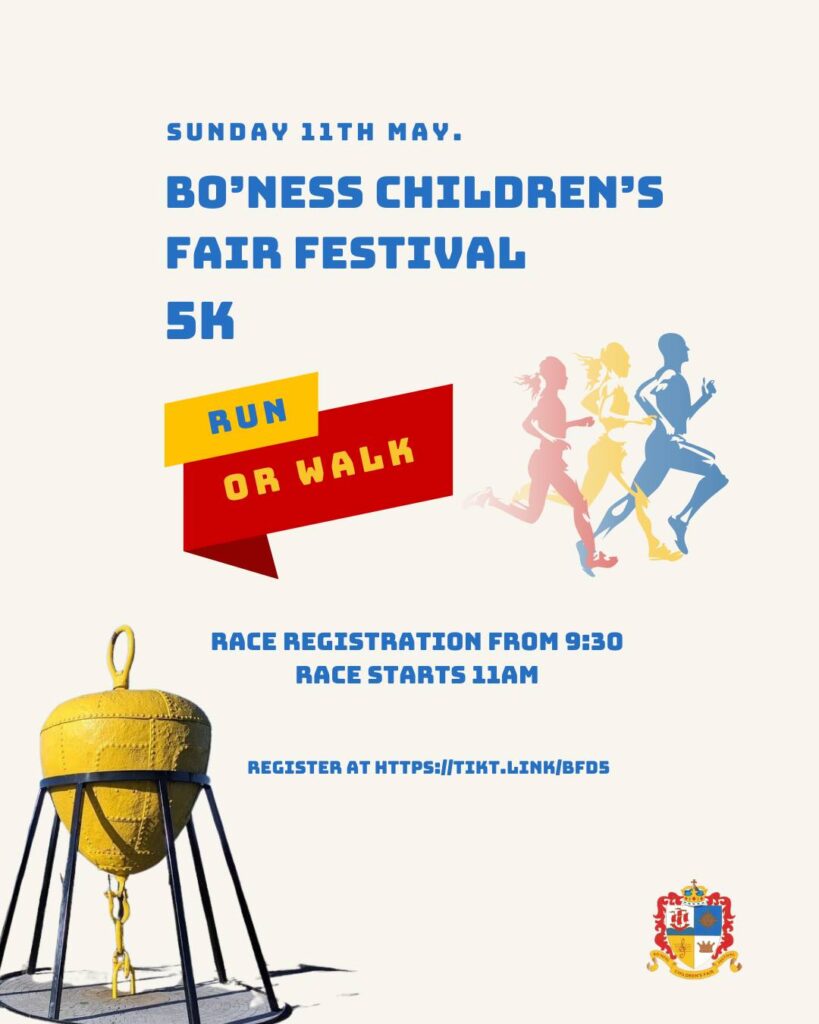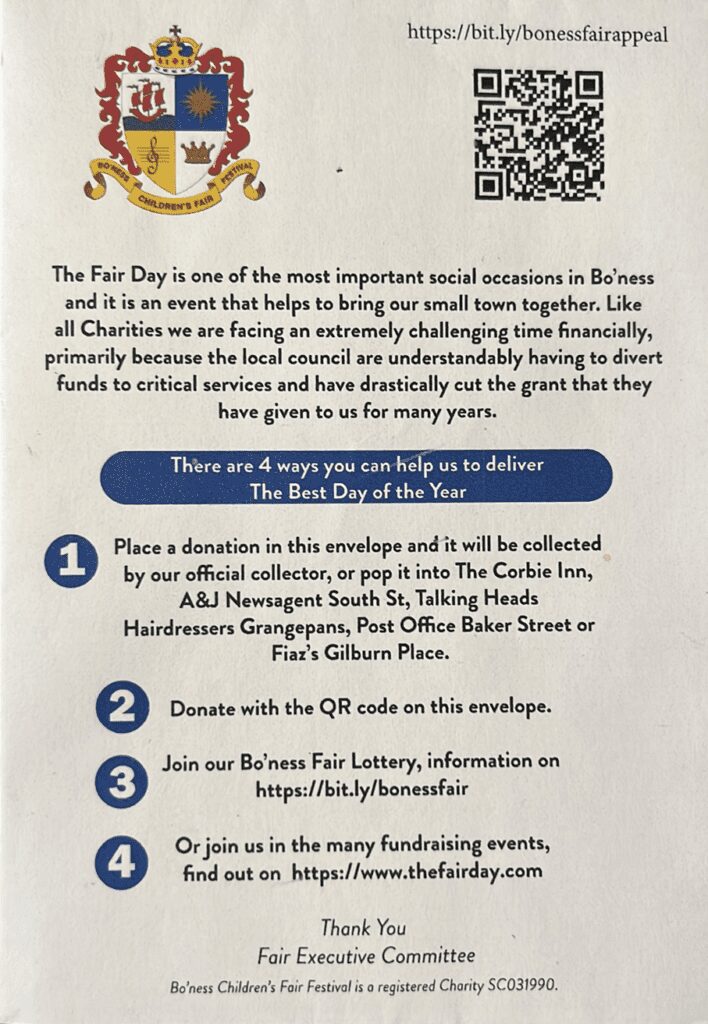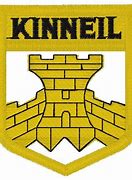“Bo’ness Fair” – words which conjure up a postcard setting for most people, a glamorous spectacle, once seen never to be forgotten. Words which for incomers who work locally mean at least an extra holiday. But for a Bo’nessian they signify a day of intense excitement which starts at 7.30 a.m. when the first strains of Carriden and Kinneil Bands can be heard, It means, a sense of pride, a feeling of belonging.
After months of planning and hard work by both adults and children, this longed-for day dawns, and excitement hits fever pitch, only to be matched in atmosphere by watching Bo’ness United lift the coveted ” Scottish Cup. ” Our pageant is the biggest and most spectacular of its kind in Scotland. It began in 1897 when George C. Stewart wanted to commemorate Queen Victoria’s Diamond Jubilee. He had once visited Lanark’s famous Lanimar Day and decided that Bo’ness should have a similar version of these festivities, but styled in their own fashion. Principally he wished to involve the children of the town.
The Fair has heralded the beginning of the miners’ holidays since then, excluding the years during both World Wars. Alas in Bo’ness this industry is no more, Kinneil Colliery being the last winder to be left standing, solely as a monument. The process of changing the face of industrial Bo’ness to an attractive residential town, is now in full progress. Once a vibrant source of the East coast which boasted Potters, Salters, Mariners and Miners: Bo’ness trades of the past, all silent, gone forever.
In this year of 1985 the honour of providing the Bo’ness Fair Festival with its principal characters falls to Kinneil Primary. They were first awarded this compliment in 1900. A year which signified, not only the turn into a century of vast change in both environmental and scientific progress worldwide, but also saw changes in the rapidly expanding town of Bo’ness.
A long-planned-for street, named after Provost Stewart, and the Glebe Park that houses the crowning in present day, were to be open for public use from the 15th July ” Fair Day. ” To mastermind the Fair is a mammoth undertaking but to have the additional task of opening a new street, then a park, and manoeuvring the procession to the other end of the town where the Queen’s crowning where the revels were to take place, was no mean feat.
As with most Fair Days the sun was on the side of the righteous, and the morning brought ideal weather conditions. In every part of the town, the locals had been up well into the night decorating houses, and putting the finishing touches to their Arches, which were then built not so much in specific gardens but across roads, as our Queen’s is today.
The proceedings of the day began when a large crowd gathered at the top of the School Brae to witness the opening of the new Street. A large boxwood Arch had been built in front of the local Jeweller, Willie Ross’s villa. This was to be the location of the opening ceremony. When Provost Stewart and other dignitaries were assembled, the former was called upon to address the crowd. He did this by explaining how long and hard the different bodies of the town had worked in situating the Street.
Mrs Drysdale, wife of the councillor in charge of roads, then cut the ribbon with gold scissors and the new ” Stewart Avenue ” was officially opened. The local company of the ” Volunteers ” ( the equivalent of the Terries now ) fired a gun salute, then the men of Bo’ness and Carriden brought the proceedings to a close with the National Anthem.
The crowd then moved on to the South East entrance of the Glebe Park where the second event of the day was to take place. The honour of opening the gates for the first time was given to councillor Law’s wife, as he was in charge of Parks. He took advantage of the fact that he had many listening ears to thank the gentlemen of the town for providing the park with seats, but then asked if someone would like to come forward and pay for a bandstand they planned to erect in the centre spot. He hoped that once built the three bands in the town would provide open air entertainment on a Saturday afternoon.
The Queen and Committee were driven through the gates in open carriages and the procession was formed at the North West corner of the park. The crowd then filtered off to claim their spot, for a bird’s eye view of the most important ceremony of the day. The retinue followed the official route via the Wynd , to West Partings, North Street, Main Street, Cowdenhill and Bridgeness to Kinnigars Park where, courtesy of Henrey Mowbrey Cadell of Grange House a platform had been constructed for the Queen’s Court.
On entering the grounds the Queen was escorted to her throne, there followed the various tasks of her courtiers, then Mrs Cadell stepped forward and crowned Miss Jennie Hunter, daughter of Kinneil School Headmaster ” Queen of Bo’ness Fair ” 1900. The ceremony was brought to a close with the singing of ” Scots Wha Hae. ”
In the afternoon the sunshine prevailed. The children dispersed to their allotted points in the park, to be supplied with refreshments before the revels began. Teachers, parents and children all took part in the races and games that followed. A much enjoyed feature of the programme was the Maypole dancing performed by the little girls of the Bo’ness Infants School ( the old Baptist Church South Street ).
The celebrations continued until 6 o’clock then, tired but exhilarated children reformed the procession. Spurred on by the bands they marched up Philpingstone Road, along Grange Terrace, finally dispersing on the new ” Stewart Avenue. ”
The Fair Festival was held mainly for the benefit of the children so the local trades held their celebrations in the afternoon, also taking the form of a procession. The Newtown, Corbiehall and Grange Miners, the local branch of the Dockers’ Union, and the carters joined forces at the Market Square then proceeded through the town to the grounds of Kinneil Estate, where they adjourned to refresh themselves after the long walk. Revived by large measures of the local Mountain Dew they set out once more to return to the town by way of Borrowstoun, Muirhouses and Carriden, each trade accompanied by their own band and led by gaily decorated whipmen on horseback.
The day was filed with events that would have exhausted the fittest. However, it was only the beginning of a week of excursions. Each trade, business, organisation, church and school had their own holiday. It began on the Saturday following the Fair when Kinneil Miners visited Berwick-on-Tweed by train. On the same day the Volunteers marched off into the sunset to join the Forth Bridge Camp at Lochore.
Sunday seems to have been their only day of rest. On Monday it was the turn of Bo’ness F.C. when, instead of taking a trip, they held their annual Sports Day at Newtown Park. For those who fancied a leisurely sail down river instead of exerting energy at Newtown: they could join a Galloway’s Steamship for a day cruise to Leith.
The men of Kinneil Band chartered Wilson’s Steamer the ” Royal Norman ” for a trip to Burntisland. Even the Merchants in the town took a day off on Wednesday when they joined ” Tug Boat Wilson ” as guests on one of his ships. The Mason’s haven lay at Elie. The it was the turn of the Churches. A steamer carried them to Alloa where they were allowed to enjoy their picnic in grounds belonging to the ” Earl of Mar.”
Steamships were undoubtedly the favourite way to travel, and were kept busy running unchartered trips to Leith. Charlestown, Aberdour, Inchkeith and the Bass Rock. However, even without Jimmy Saville, the railway was able to get in on the scene by having special offer days.
This exciting one day trip was probably enjoyed as much as the now taken for granted fortnight in Majorca or Tenerife. They must have been glad to get back to work for a rest, the entire week being full of festivities.
The ” Bo’ness Fair Day ” basically remains the same in present time only bigger and brighter. This great occasion brings back many exiled sons and daughters from every ” airt of the globe.” If, for reasons, there are some who cannot make the journey, it is not unknown for ” Our Festival Day ” to be heard being sung at ” Wee fairs ” in the ” Australian Bush ” or the ” Great Forests of Canada.” It’s said that on this day homesickness is at its worst among ex-Bo’nessians.
For those who come to spectate the proceedings are all very enjoyable, but the work that goes on behind the scenes to ensure the success of this event is never fully appreciated. From Committee, to the individuals who continually dip into their pocket beforehand, and hang out their string of flags on the day, everyone likes to do their bit. For, to a Bo’nessian nothing is too much troublefor the Fair.
Although in this year of 1985 ” Dirty Bo’ness ” as Rabbie christened it, has had a face wash, it still holds fast the memories of days gone by. Here’s hoping it will continue to do so, with the promise of many happy “Fair Days” to come.
VALERIE McKAY






